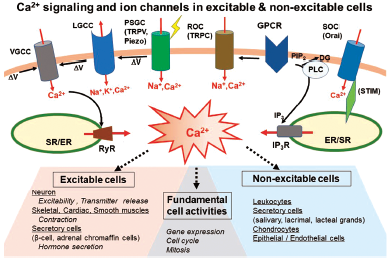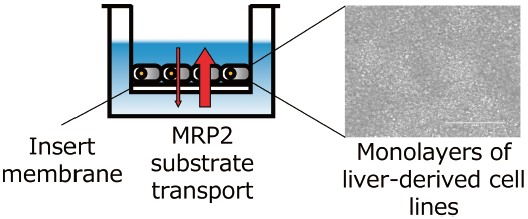- |<
- <
- 1
- >
- >|
-
 2022 Volume 45 Issue 1 Pages 1-18
2022 Volume 45 Issue 1 Pages 1-18
Published: January 01, 2022
Released on J-STAGE: January 01, 2022
Editor's pickAbout the cover: Cellular Ca2+ signaling functions as one of the most common second messengers of various signal transduction pathways in cells and mediates various physiological roles depending on cell-types and their excitability. Among ion channels, Ca2+-permeable channels in the plasma membrane as well as endo- and sarcoplasmic reticulum membranes play important roles in cellular Ca2+ signaling. Ca2+-gated ion channels indicated by the star (★) often crosstalk reciprocally with Ca2+ signals and are central to the regulation of cellular functions. Ca2+-gated ion channel works as a converter of Ca2+ signals to propagative electrical signals and plays key roles in the opposite feedback regulation of Ca2+ signaling in excitable and non-excitable cells.
Download PDF (15838K) Full view HTML -
2022 Volume 45 Issue 1 Pages 19-26
Published: January 01, 2022
Released on J-STAGE: January 01, 2022
Advance online publication: October 30, 2021Download PDF (1578K) Full view HTML
-
2022 Volume 45 Issue 1 Pages 27-33
Published: January 01, 2022
Released on J-STAGE: January 01, 2022
Download PDF (3629K) Full view HTML -
 2022 Volume 45 Issue 1 Pages 34-41
2022 Volume 45 Issue 1 Pages 34-41
Published: January 01, 2022
Released on J-STAGE: January 01, 2022
Editor's pickImatinib mesylate is a potent tyrosine kinase inhibitor. It is known that in addition to targeting the oncogenic drivers, the immune system plays an important role in exerting therapeutic effects of imatinib and restraining the emergence of escape mechanisms. However, its influence on the recruitment of effector T cells into the tumors has not been investigated. Authors found that imatinib significantly enhanced the expression of CD8 T cell-recruiting cytokine genes, leading to antitumor effects, which was dependent on the tumor type. This study elucidated a new mechanism of antitumor immunity induced by imatinib.
Download PDF (1259K) Full view HTML -
2022 Volume 45 Issue 1 Pages 42-50
Published: January 01, 2022
Released on J-STAGE: January 01, 2022
Advance online publication: October 30, 2021Download PDF (14995K) Full view HTML -
2022 Volume 45 Issue 1 Pages 51-62
Published: January 01, 2022
Released on J-STAGE: January 01, 2022
Advance online publication: November 03, 2021Download PDF (2223K) Full view HTML -
2022 Volume 45 Issue 1 Pages 63-70
Published: January 01, 2022
Released on J-STAGE: January 01, 2022
Download PDF (4222K) Full view HTML -
2022 Volume 45 Issue 1 Pages 71-76
Published: January 01, 2022
Released on J-STAGE: January 01, 2022
Download PDF (1379K) Full view HTML -
2022 Volume 45 Issue 1 Pages 77-85
Published: January 01, 2022
Released on J-STAGE: January 01, 2022
Advance online publication: October 30, 2021Download PDF (3613K) Full view HTML -
2022 Volume 45 Issue 1 Pages 86-93
Published: January 01, 2022
Released on J-STAGE: January 01, 2022
Download PDF (1938K) Full view HTML -
2022 Volume 45 Issue 1 Pages 94-103
Published: January 01, 2022
Released on J-STAGE: January 01, 2022
Download PDF (1925K) Full view HTML -
 2022 Volume 45 Issue 1 Pages 104-113
2022 Volume 45 Issue 1 Pages 104-113
Published: January 01, 2022
Released on J-STAGE: January 01, 2022
Editor's pickGlycosides are often included as active ingredients in natural medicines. Many glycosides are highly water-soluble, and they are metabolized by intestinal bacteria before being absorbed in the digestive tract. Glycyrrhizic acid (GL), one of the main components of yokukansan, is a glycoside that is metabolized by intestinal bacteria to glycyrrhetinic acid (GA). This study investigated the gut microbiota compositions and pharmacokinetics of GL in yokukansan. The results suggest that oral antibiotics affect the plasma level of GA, and that the blood level of GA changes depending on the gut microbiota composition.
Download PDF (2722K) Full view HTML -
2022 Volume 45 Issue 1 Pages 114-117
Published: January 01, 2022
Released on J-STAGE: January 01, 2022
Advance online publication: October 16, 2021Download PDF (478K) Full view HTML -
2022 Volume 45 Issue 1 Pages 118-123
Published: January 01, 2022
Released on J-STAGE: January 01, 2022
Download PDF (544K) Full view HTML -
 2022 Volume 45 Issue 1 Pages 124-128
2022 Volume 45 Issue 1 Pages 124-128
Published: January 01, 2022
Released on J-STAGE: January 01, 2022
Advance online publication: November 02, 2021Editor's pickToxicological profiles of chemicals have been investigated in rodents, but new alternative methods to evaluate compound safety are being developed worldwide using in silico approaches. Physiologically based pharmacokinetic (PBPK) modeling has the potential to play significant roles in estimating internal chemical exposures. The authors generated three major PBPK model input parameters (i.e., absorption rate constants, volumes of the systemic circulation, and hepatic intrinsic clearances) for chemicals using machine learning algorithms. The input parameters for humans of compounds can be reliability estimated using chemical descriptors calculated using in silico tools for illustrating virtual maximum plasma concentrations and areas under the curve.
Download PDF (598K) Full view HTML -
2022 Volume 45 Issue 1 Pages 129-135
Published: January 01, 2022
Released on J-STAGE: January 01, 2022
Download PDF (2106K) Full view HTML -
2022 Volume 45 Issue 1 Pages 136-142
Published: January 01, 2022
Released on J-STAGE: January 01, 2022
Download PDF (4085K) Full view HTML -
2022 Volume 45 Issue 1 Pages 143-149
Published: January 01, 2022
Released on J-STAGE: January 01, 2022
Advance online publication: October 26, 2021Download PDF (1897K) Full view HTML
-
 2022 Volume 45 Issue 1 Pages 150-153
2022 Volume 45 Issue 1 Pages 150-153
Published: January 01, 2022
Released on J-STAGE: January 01, 2022
Editor's pickThis report reveals that monolayers of human liver-derived cell lines grown on a membrane exhibit directional transport, i.e. efflux transport of a substrate of multidrug resistance-associated protein 2 (MRP2). The transport was suppressed by an MRPs inhibitor, supporting the idea that MRP2 is the primary mediator of directional transport. The advantage of this system is its potential to quantitatively evaluate biliary excretion of MRP2 substrates in vitro. The assay system may therefore be utilized for the screening of biliary excretion drugs and for investigating the hepatotoxicity of candidate drugs.
Download PDF (401K) Full view HTML
-
2022 Volume 45 Issue 1 Pages 154
Published: January 01, 2022
Released on J-STAGE: January 01, 2022
Download PDF (132K) Full view HTML
- |<
- <
- 1
- >
- >|



















